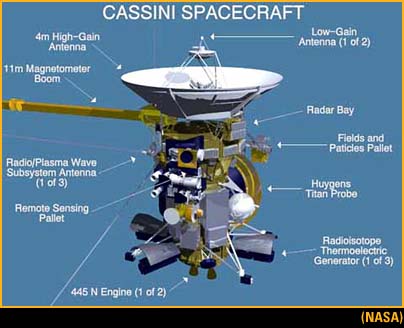Cassini (spacecraft)


Cassini at Saturn.

Cassini spacecraft.
Cassini is a NASA and European Space Agency spacecraft to the planet Saturn, which was launched on 13 October 1997. The 5,650-kilogram (12,450-pound) spacecraft went into orbit around Saturn in June 2004 after a gravity-assisted journey that took it twice around Venus and once each around the Earth and Jupiter. Upon arrival, Cassini engaged in a series of complex orbital maneuvers in order to achieve its major science goals, which include observing Saturn's near-polar atmosphere and magnetic field from high inclination orbits, several close flybys of the icy satellites Mimas, Enceladus, Dione, Rhea, and Iapetus, and multiple flybys of Saturn's large, enigmatic moon Titan. A high point of the mission was the release of the Huygens Probe and its descent into Titan's atmosphere.
Experiments aboard the orbiter include: the Imaging Science Subsystem, the Cassini Radar, the Radio Science Subsystem, the Ion and Neutral Mass Spectrometer, the Visible and Infrared Mapping Spectrometer, the Composite Infrared Spectrometer, the Cosmic Dust Analyzer, the Radio and Plasma Wave Spectrometer, the Cassini Plasma Spectrometer, the Ultraviolet Imaging Spectrograph, the Magnetospheric Imaging Instrument, and the Dual Technique Magnetometer. Cassini is about the size of a 30-passenger school bus.


